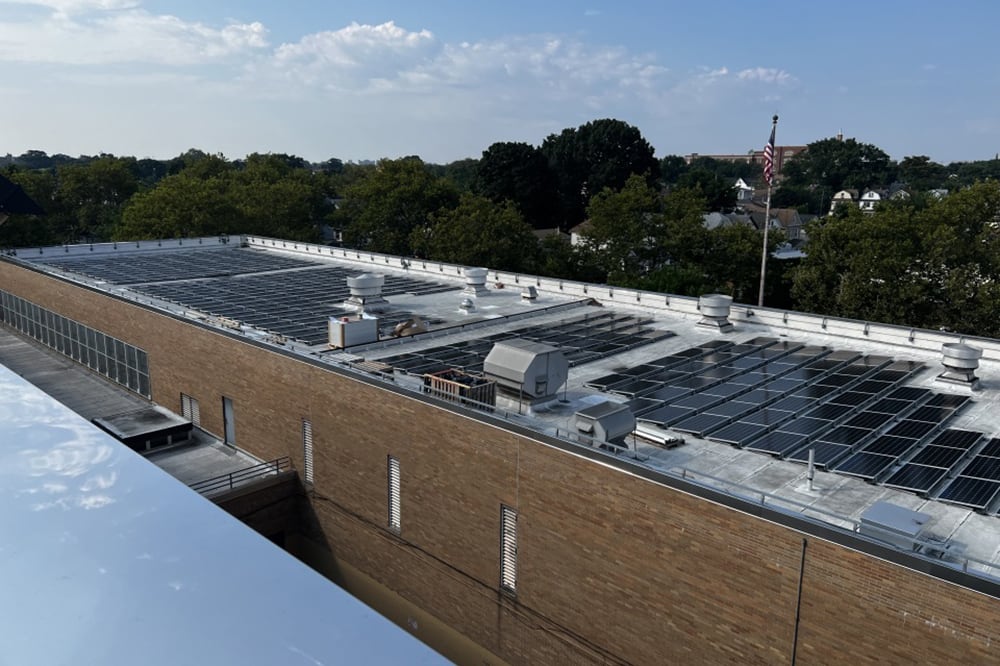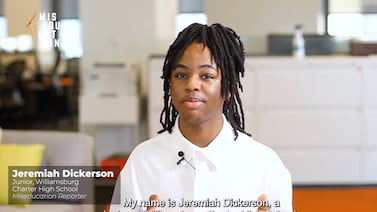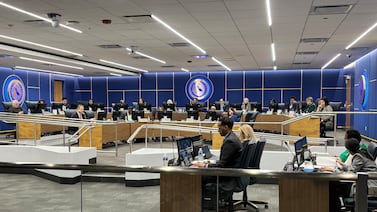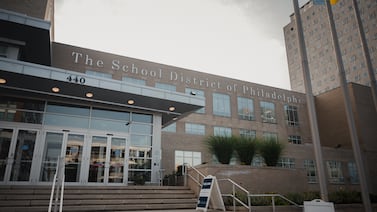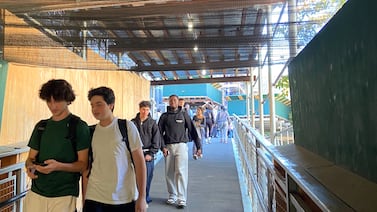Sign up for Chalkbeat New York’s free daily newsletter to get essential news about NYC’s public schools delivered to your inbox.
With solar panels on 126 school building rooftops, New York City schools are central to the city and state’s green energy goals and generate the majority of solar energy installed on municipal buildings.
These solar arrays produce nearly 20 megawatts — enough to power about 24,000 city households — and make up roughly 80% of the overall solar power capacity from city buildings. They are also critical to achieving a local mandate of 150 megawatts of solar citywide by 2035.
Experts say school solar projects not only cut energy costs and reduce emissions, but also ease students’ climate anxiety and strengthen community resilience during emergencies. More than half of FEMA’s approximately 67,500 designated shelters nationwide are located in schools, making it more urgent to equip them with solar storage systems that can provide backup power during outages.
Solar has even entered the mayoral race: Zohran Mamdani has highlighted it in his green schools platform, one of the first education policies the mayoral frontrunner put forth.
But solar projects now face uncertainty under the “one big beautiful bill” signed by President Donald Trump in July. Under the law, federal tax credits that have incentivized and funded school solar initiatives are set to expire by the end of 2027, leaving districts scrambling to initiate and complete projects before the phaseout. Tax credits generally pay for 30% of installation costs.
It’s one of several blows to school systems that want to be more green, including cuts to federal grants for electric school buses.
Advocates are urging schools to start new solar projects before the end of this calendar year and finish by June 2026 — a window that would allow them to circumvent many of the new restrictions in the law that, they warn, could make it harder for schools to qualify for credits.
“ What I don’t want to have happen is for schools to unwittingly move forward, be counting on that credit, and then be surprised if one of these new rules trips them up,” said Sara Ross, cofounder of UndauntedK12, a nonprofit that supports K-12 public schools’ transition to clean energy.
New York City schools are pressing ahead on solar work, with an additional 90 solar projects in progress and another 200 schools under review for future installations, officials said.
“New York City Public Schools remains committed to sustainability and climate education for our students,” Education Department spokesperson Jenna Lyle said in a statement.
Department officials did not comment directly on the federal legislation, saying they are “monitoring this situation.”
To pay for the 126 school solar installations, Education Department officials said the city invested $30 million in capital funds and an additional $100 million through long-term power purchase agreements, an arrangement where private developers pay for installation of a solar system and schools agree to pay the developer for the electricity they use, typically over a long period of time.
Schools’ role in transitioning to clean energy
Although they account for just 1% of total carbon emissions in the United States, school buildings produce an estimated range of 41 million to 72 million metric tons of carbon dioxide, according to researchers at Brown University. They also consume a significant amount of energy.
In 2019, New York’s roughly 1,400 school facilities accounted for more than a third of all energy consumption across city-owned buildings.
The city’s Education Department already spends about $275 million per year on energy, a figure experts say is likely to grow as utility costs rise and aging school facilities face mounting stress from extreme weather tied to climate change.
But schools’ size — they make up 36% of all city-owned square footage — also make them ideal stewards of clean energy.
“Schools have a lot of land, they have a lot of assets,” said Ross. “When sunlight is hitting those every day, why wouldn’t we be harvesting that sunlight to reduce our costs?”
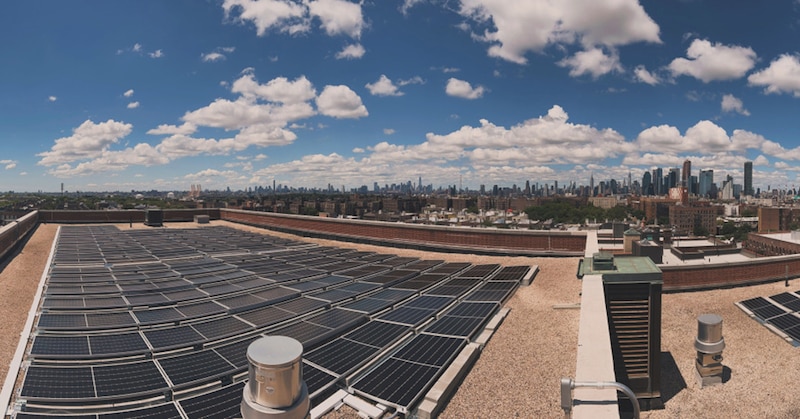
New York schools installed their first rooftop solar arrays nearly 20 years ago, Education Department officials said. But the program’s expansion didn’t gain momentum until 2021, with installations ramping up in the last five years.
The city is currently developing solar and battery storage systems at five schools in partnership with several city agencies. Among them are P.S. 48 and M.S. 424 in the Bronx, both of which double as emergency shelters.
Education department officials said they could not provide an estimate of how much money completed projects have saved to date, but added that in the long term, the city will have saved more than it has spent on solar installation. Ross said those savings can help schools afford other needs.
“ School budgets are tight, and fundamentally, solar is the cheapest energy around, so when schools install solar, they can reduce their operating costs,” Ross said. “That frees up more dollars to go back into their core mission — whether that’s improving other parts of their facility, having more dollars for student programming, and increasing teacher salaries.”
Karin Goldmark, founder of GreenLink Education, an organization that helps schools take climate action, noted that rising temperatures will contribute to higher energy costs.
“It’s worth it to do solar, particularly if you have 1,400 buildings and you’re paying energy bills for all of them,” she said.
Goldmark said that in the summer, when school buildings sit largely empty, they can sell excess solar power back to utilities, thereby providing clean energy that offsets the need for gas-fired plants.
“That’s an important contribution to the energy transition the country needs to make, and it generates revenue for schools in the process,” she said.
Funding school solar projects
Installing solar panels can deliver major long-term savings, but the upfront costs are steep and often out of reach for school districts, especially those that want to install large-scale solar projects like in New York City.
The Inflation Reduction Act, signed under former President Joe Biden, changed that by opening up clean energy tax credits to schools in 2022. Although schools are tax-exempt and cannot claim credits directly, an “elective pay” provision allowed them to convert those credits into cash reimbursements. That effectively created new funding for solar and other clean energy projects — with virtually no cap, Ross said.
“We have spent the last three years shouting this from every rooftop, going to conferences of superintendents and business officers and school board members and facilities leaders and really spreading the word about this massive opportunity to have the federal government defray the cost of these very energy and cost-efficient machines,” she said.
Now, UndauntedK12 and other clean energy advocates are working to educate schools on how to make the most of the tax credits before they disappear.
In addition to the narrow timeline for initiating and completing school solar projects, a process experts note can take years, “the one big beautiful bill” imposes a new set of restrictions schools must follow in order to qualify for tax credits.
One requirement, for example, mandates that a share of solar panels be sourced and assembled domestically.
Solar developer Jared Lang said that the rule is driving up costs, since domestic solar developers have long relied on imported materials after Chinese manufacturers flooded the American market years ago.
“All the new tax credit requirements forcing us to use domestically assembled panels are basically costing us about 50% more,” said Lang, who also owns Housing Sustainability Advisors, which supports affordable housing owners in moving to solar.
“It’s really going to affect how much solar we can build,” Lang said.
Ross said that while the expiration of tax credits will make the transition to solar more challenging, schools funded projects before the Inflation Reduction Act created new clean energy incentives.
She pointed to power purchase agreements as a longstanding, affordable method for schools to launch solar projects.
“There’s a path forward, even for districts that don’t have money,” Ross said.
Seyma Bayram is a New York City-based journalist.

